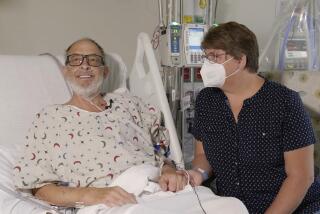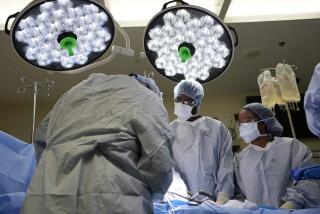Doctors report success in penis transplant for injured veteran
- Share via
It is perhaps the combat injury most feared by servicemen who have deployed to Iraq and Afghanistan: a blast that robs them of their genitals.
For one such wounded warrior, a real shot at renewed sexual health and happiness has come with a transplanted penis, scrotum and lower abdominal wall. The transplant, which also included many of the nerves, muscles and blood vessels that serve those organs, is described in Thursday’s edition of the New England Journal of Medicine.
The recipient is a young serviceman who lost his penis, scrotum, both testes and most of both legs when he stepped on a roadside bomb in Afghanistan.
Now, roughly 19 months after his penis transplant, the veteran can urinate while standing up on his prosthetic legs and enjoys what his doctors at the Johns Hopkins School of Medicine described as a “strong stream.” He also has normal sensation on both the shaft and the tip of his new penis, near-normal erections and can achieve orgasm.
For the rest of his life, the man will almost certainly take anti-rejection medication, making him more vulnerable to infections, kidney problems and certain cancers. And he cannot father biological children: ethical considerations forbade the transfer of testes, which would have generated semen bearing the DNA of his deceased donor.
Still, for a young man whose injuries were too extensive for conventional reconstructive surgery, having an external appendage that feels and works like the one he had “is a big deal,” said Dr. Richard Redett, the transplant surgeon who led a team of roughly 35 medical professionals in a 14-hour operation.
In the report, Redett and his team wrote that the unnamed serviceman reports “feeling whole” again. He continues to live independently and has returned to school full time.
He is “very satisfied with the transplant and the implications it carries for his future,” the medical team concluded.
The case is the fourth-ever successful transplant of a penis from a donor to a patient who has lost his to disease or injury. But it is by far the most extensive transplant of genitalia to date. It was performed in Baltimore in March 2018 by a team that has pushed the boundaries of transplants of soft tissue such as hands and faces.
“This is a real quantum leap,” said Dr. Curtis Cetrulo, a transplant surgeon at Massachusetts General Hospital who led the group that performed the first penis transplant in the United States in 2016.
To restore this veteran’s external genitals, Cetrulo said the Hopkins team built on knowledge gained not only from the first three penis transplants, but from roughly 100 hand transplants and 140 face transplants.
Each of these procedures has yielded important insights about connecting blood vessels narrower than the diameter of a human eyelash, about how long it takes for nerves to regenerate, and about what it takes to ward off rejection of soft tissues, Cetrulo said.
Redett said his team spent close to five years laying the groundwork for the operation. On human cadavers and in rats, they practiced the delicate work of fusing nerves, arteries and tissue that would normally shrink from the cold steel surgical instruments are made of. They investigated which parts of this anatomical complex were most prone to rejection by the immune system (the urethra, it turns out) and how that could be detected quickly and prevented.
“We learned a lot” from Cetrulo’s work and from two penis transplants performed by a team in South Africa, Redett said.
The veteran had arrived seeking a conventional penile reconstruction. In those cases, surgeons fashion a “neophallus” from fat and skin taken from the forearm or thigh. After incorporating a pump to facilitate erection, reconstructive surgeons attach the penis to an existing urethra, blood vessels and nerves.
But Redett said the extent of this patient’s injuries made that approach impossible. Instead, he and his colleagues realized they had a physically and psychologically robust candidate for an experimental procedure that would demand meticulous compliance with a lifelong medication regimen.
The plan was put into action on a Saturday in late March of last year as another young man who shared the veteran’s blood type and skin tone lay in a hospital room in a twilight between life and death. An organ procurement team approached the young man’s bereaved family members about donating their loved one’s genitals.
“It is harder to ask a family for a face or a penis,” Redett acknowledged. But often, he said, a shared connection between donor and recipient — say, professions or hobbies or military service — will prompt a family to say yes. (The relatives of the donor wished to remain anonymous and did not discuss their decision.)
Early Monday morning, Redett’s team — including microvascular surgeons, urologists, transplantation specialists, anesthesiologists and an army of skilled helpers — went to work fusing the complex of external organs to their young patient.
The decades-long conflicts in Iraq and Afghanistan have produced a generation of servicemen whose reproductive organs have been compromised by improvised explosive devices.
A 2017 study conducted for the Pentagon found that between October 2001 and August 2013, 1,367 servicemen experienced genitourinary wounds, more than a third of them considered “severe.” Some 423 involved the penis, 451 damaged the testes, and 760 — more than half — involved the scrotum.
These injuries need more attention to identify “novel treatments to improve sexual, urinary and/or reproductive function,” the study authors, from the U.S. Army Institute of Surgical Research and the San Antonio Military Medical Center, wrote. Sexual and urinary function are important to men, and “they have not been part of the polytrauma repertoire.”
In earlier conflicts, most of these men would not have survived the trauma inflicted on the battlefield. But body armor that protects an infantryman’s chest and midsection, as well as faster and more effective emergency medical care and evacuation practices, have meant that many such men have come home to contend with life-altering injuries.
Unchanging across conflicts, however, is the fear that such injuries provoke in combatants.
“Many soldiers we’ve evaluated for injuries have told us that when they come to, they first look to see if they’ve lost their genitals. And then, they look for their legs,” Redett said.
The impact of such injuries on the fertility of returning servicemen has spurred the Wounded Warrior Project to lobby Congress and the Department of Veterans Affairs to make funds available for fertility treatments for affected service members. Those efforts succeeded in 2017.
The organization said it “is encouraged by the results Johns Hopkins Medical Center achieved.”
IED injuries to lower extremities “are, unfortunately, quite common to wounded veterans who served in Iraq and Afghanistan,” the group said in a statement.
The cost of vets’ conventional penile reconstruction is covered by the VA. But penis transplants remain highly experimental — and for many potential recipients, they come with risks that are hard to justify for a treatment that does not save lives. Redett said Johns Hopkins funded the surgery and the research leading up to it and the VA will underwrite the lifelong cost of his anti-rejection medication.
After healing from his initial wounds, the patient was left with a 1.5-centimeter-long remnant of penile tissue with a urethra. His lower abdominal wall had been blown away. He had extensive scar tissue, and many of the blood vessels that would normally bring blood to the penis were either gone or unusable.
As part of the transplant, Redett said the surgeons repurposed arteries from the stomach area which normally supply blood to the abdominal muscles.
In the months after his surgery, a single episode of rejection was easily treated with topical steroids and tacrolimus, the single anti-rejection medication the patient takes.
The proliferation of nerve endings that make the penis exquisitely sensitive are generally thought to begin regenerating only after a month, and proceed outward toward the skin at a pace of one millimeter a day.
For the young serviceman, that process may have been enhanced by a happy accident: Tacrolimus, the anti-rejection drug, sends nerve regeneration into overdrive. Within a few months, the patient reported sensation in his new penis, and his continued recovery “has exceeded my expectations,” Redett said.
Cetrulo said that the renewal of sensation in transplanted soft tissue has continued to amaze physicians. Three years after getting a donor penis, his own patient continues to see progress. Hand transplant patients are reporting leaps in sensitivity as long as five years after surgery.
“We are in uncharted waters,” Cetrulo said. “You have to check your assumptions at the door.”







